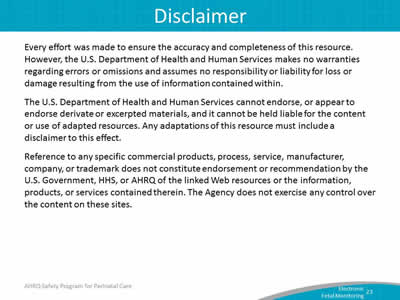Monitoring for Perinatal Safety: Electronic Fetal Monitoring: Facilitator Guide
AHRQ Safety Program for Perinatal Care
Slide 1: Monitoring for Perinatal Safety: Electronic Fetal Monitoring
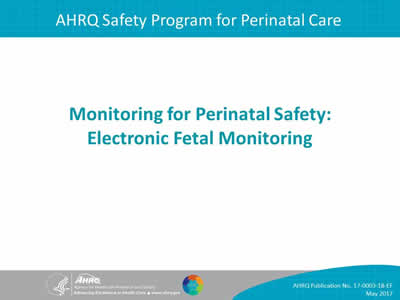
Say:
The Monitoring for Perinatal Safety bundle provides information on the use of electronic fetal monitoring (EFM). This bundle offers an approach to the use of EFM based on key safety elements.
Slide 2: Learning Objectives
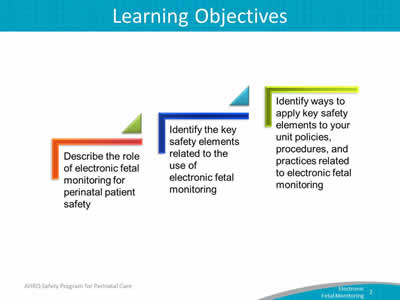
Say:
In this module, we will do the following:
- Describe the role of EFM for perinatal patient safety.
- Identify the key safety elements related to the use of EFM.
- Identify ways to apply key safety elements to your unit policies, procedures, and practices related to EFM.
Slide 3: Electronic Fetal Monitoring
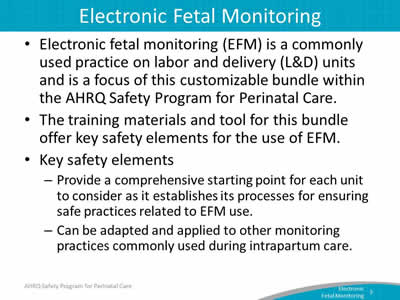
Say:
Monitoring fetal heart rate, or FHR, and contractions during labor, whether done intermittently or continuously, is a commonly used practice on labor and delivery, or L&D, units. This module will not cover the evidence regarding the various approaches to fetal monitoring (for example, intermittent auscultation vs. continuous electronic monitoring) but rather will focus on strategies and approaches to improving patient safety through safe use of EFM.
The training materials and tool for this bundle offer key safety elements for the use of EFM. The key safety elements discussed provide a comprehensive starting point for each unit to consider as it establishes its processes for ensuring safe practices related to EFM use. These key elements can be adapted and applied to other monitoring practices commonly used during intrapartum care.
Slide 4: EFM and Perinatal Safety
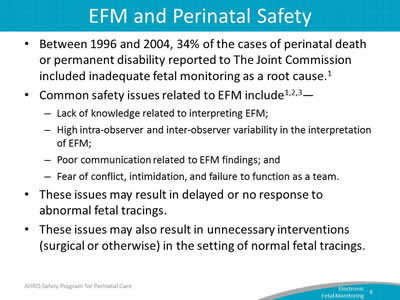
Say:
Between 1996 and 2004, 34 percent of the cases of perinatal death or permanent disability reported to The Joint Commission under its sentinel event-reporting policy included inadequate fetal monitoring as a root cause.
Common safety issues related to the use of EFM include staff with inadequate knowledge or training to correctly interpret EFM strips; intra- and inter-observer variability in EFM interpretation; poor communication among team members related to EFM interpretation; and the fear of conflict, intimidation, and/or failure to function as a team.
These issues may result in delayed or no response to abnormal EFM findings.
In addition, these issues may result in unnecessary interventions (surgical or otherwise) in the setting of normal EFM findings.
Slide 5: Perinatal Safety and Professional Liability
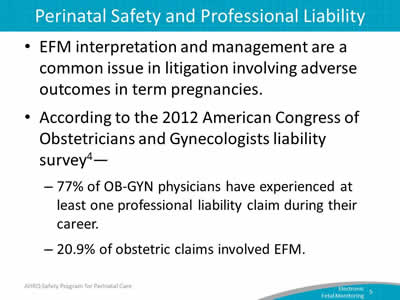
Say:
Further, EFM interpretation and management is a common issue in litigation involving adverse outcomes in term pregnancies.
According to the 2012 American Congress of Obstetricians and Gynecologists liability survey—
- 77 percent of OB-GYN physicians have experienced at least one professional liability claim during their career.
- 20.9 percent of obstetric claims involved EFM.
Slide 6: Rationale for Safe EFM
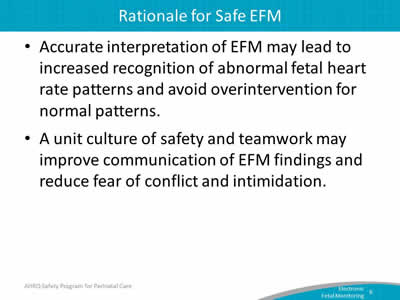
Say:
Accurate interpretation of EFM may lead to increased or earlier recognition of abnormal fetal heart rate patterns and avoid over-intervention for normal patterns.
However, improving individual staff skills with respect to EFM interpretation may not be enough to reduce perinatal safety events related to EFM use.
A unitwide approach for safe EFM supports increased staff knowledge and skills for more accurate EFM interpretation, and supports an organizational culture of safety and teamwork that improves communication of EFM findings and reduces fear of conflict and intimidation among L&D unit staff.
Slide 7: Safe EFM Tool
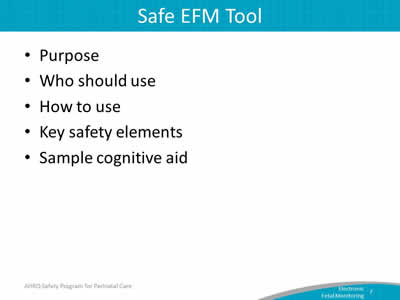
Say:
The purpose of the tool is to describe the key perinatal safety elements that support the safe use of EFM. Key safety elements are presented within the framework of the Comprehensive Unit-based Safety Program (CUSP) and describe what should be included for a unitwide approach to the safe use of EFM.
Nurses, physicians, midwives, and other L&D staff responsible for assessment, interpretation, management, communication, and documentation of fetal heart rate patterns and uterine activity observed through EFM can use this tool.
To use the tool, staff should review the key safety elements with L&D leadership and unit staff, determine how to implement elements within their unit, and consider existing facility processes or policies related to EFM.
The key safety elements will be reviewed in subsequent slides in more detail.
This tool also offers a sample cognitive aid for standardized EFM nomenclature as an appendix.
Slide 8: Key Perinatal Safety Elements for EFM
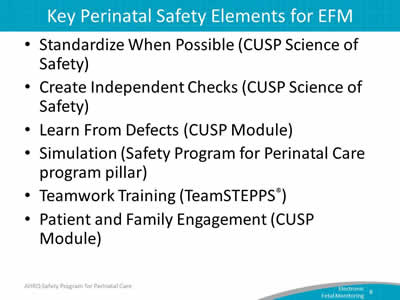
Say:
As in the other customizable bundles available through the AHRQ Safety Program for Perinatal Care, the key safety elements for EFM are organized into the following six overarching principles of patient safety derived from CUSP:
- Standardize When Possible.
- Create Independent Checks.
- Learn From Defects.
- Simulation.
- Teamwork Training.
- Patient and Family Engagement.
In the rest of this presentation, we will highlight each of these key safety elements and ways they apply to the safe use of electronic fetal monitoring.
Slide 9: Key Safety Elements: Standardize When Possible
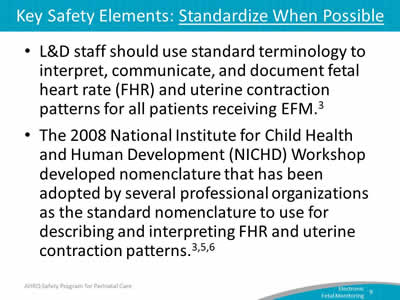
Say:
Use of the standard National Institute for Child Health and Human Development (NICHD) nomenclature and three-tiered system for interpreting, communicating, and documenting EFM findings provides a common language for use among providers and staff to decrease variation and provide accurate communication between caregivers.
The 2008 NICHD Workshop developed standardized nomenclature to use for describing FHR and uterine contraction patterns. According to this standard, a complete description of an EFM tracing requires a qualitative and quantitative 0assessment of uterine contractions, baseline FHR, baseline FHR variability, presence of FHR accelerations, periodic or nonperiodic FHR decelerations, and changes in trend over time.
NICHD also proposed a three-tiered system for EFM interpretation. It links observed FHR findings to fetal acid-base status and can suggest a general clinical management strategy in terms of—
- normal findings suggesting expectant management.
- indeterminate findings suggesting reevaluation and continued surveillance.
- abnormal findings suggesting prompt evaluation and possible intervention.
Use of the standard three-tiered system for interpreting and communicating FHR tracings provides a common language for use among providers and staff to decrease variation and provide accurate communication between caregivers.
Slide 10: Key Safety Elements: Standardize When Possible
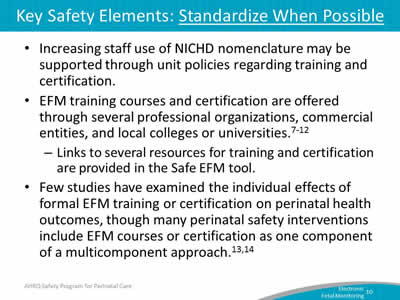
Say:
Increasing staff use of NICHD nomenclature may be supported through unit policies regarding training and certification.
EFM training courses and certification are offered through several professional organizations, commercial entities, and local colleges or universities.
- Several resources for training and certification are provided in the Safe EFM tool.
Few studies have examined the isolated and independent effect of formal EFM training or certification on perinatal health outcomes, though many perinatal safety interventions include EFM courses or certification as one component of a multicomponent approach to improving perinatal quality and safety.
Slide 11: Key Safety Elements: Standardize When Possible
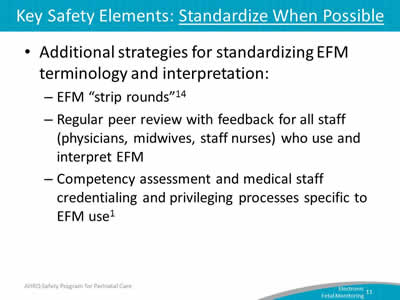
Say:
In addition to formal training or certification, other strategies may support staff use of standardized terminology.
EFM “strip rounds” refers to periodic, multidisciplinary review of actual EFM strips from past patients for the purposes of teaching and learning in a team environment. The emphasis of strip rounds is on practicing the use of standardized terminology for describing and communicating the findings from the strip. Strip rounds can be used to practice differentiating Category I, II, and III tracings, and discussion of the standard unit approach for responding to each category of tracing.
Regular peer review with feedback for all staff (physicians, midwives, staff nurses) who use and interpret EFM is another strategy that can be used to support use of standard nomenclature.
Last, nurse competency assessment and medical staff credentialing and privileging processes specific to EFM use may be another strategy for improving standardization of EFM interpretation and communication.
Slide 12: Key Safety Elements: Create Independent Checks
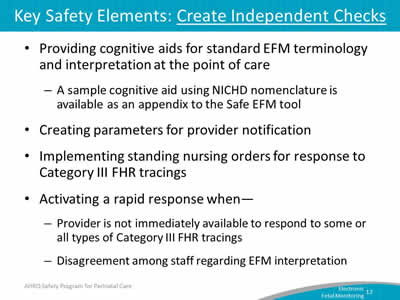
Say:
Clinician pocket cards and bedside reference aids that define and describe the 2008 NICHD nomenclature and three-tiered system for interpretation can be used to provide quick access for staff reference. A sample cognitive aid with NICHD nomenclature is provided in the appendix of the Safe EFM tool.
Use of uniform, unit-established parameters for provider notification of EFM findings ensures that signs of potential adverse effects or clinical deterioration are communicated for situational awareness and response if needed.
Last, units can establish standing orders for first-line response to Category III FHR tracings. Standing orders for first response to Category III tracings may include nursing orders for maternal oxygen, maternal repositioning, discontinuing labor-stimulating agents, and treatment of hypotension with intravenous fluids. Standing orders may also include nurse activation of a rapid response or escalation policy for certain EFM findings if the maternity care provider is not immediately available at the bedside or there is disagreement among staff.
Slide 13: Key Safety Elements: Learn From Defects
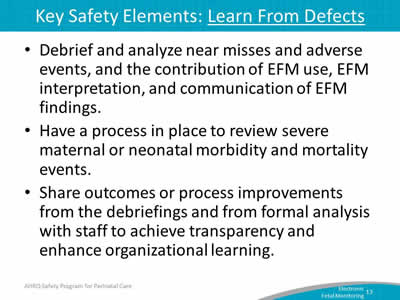
Say:
A unit can decide its approach to debriefing events based on seriousness of event, expertise available, and data monitoring and tracking capabilities.
Informal debriefings can be used by the clinical team immediately following a near miss or actual adverse event using an approach that does not shame or blame individuals. This allows for understanding of what went well, what could have gone better, and what could be done differently next time.
Another option is a regular forum with a multidisciplinary team that uses formal tools or analysis for learning from defects and sensemaking, including some of the methods described in earlier CUSP modules.
Each unit can decide its approach to reviewing cases of severe maternal or neonatal morbidity or mortality. This might include an existing medical peer-review process or review by a perinatal safety or quality committee.
Note: A sample process and forms for a committee review are available from the Council on Patient Safety in Women’s Health Care, and links to these forms are in the tool.
Sites can also decide how often, how much, and to whom information learned from debriefings or formal analysis is shared with staff to achieve transparency and enhance organizational learning.
Slide 14: Key Safety Elements: Simulation
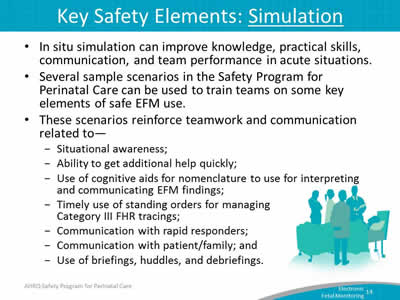
Say:
In situ simulation can improve knowledge, practical skills, communication, and team performance in acute situations.
Several of the sample scenarios available through the Safety Program for Perinatal Care can be used to train teams on some of the key safety elements related to safe EFM use. The most relevant sample scenarios for use are those describing antepartum or intrapartum situations. Some of these scenarios use a change in fetal status as evidenced by new EFM findings as a simulation trigger.
These scenarios reinforce teamwork and communication related to the following:
- Situational awareness.
- Ability to get additional help quickly.
- Use of cognitive aids for nomenclature to use for interpreting and communicating EFM findings.
- Timely use of standing orders for managing III FHR tracings.
- Communication with rapid responders.
- Communication with patient/family.
- Use of briefings, huddles, and debriefings.
Slide 15: Key Safety Elements: Teamwork Training
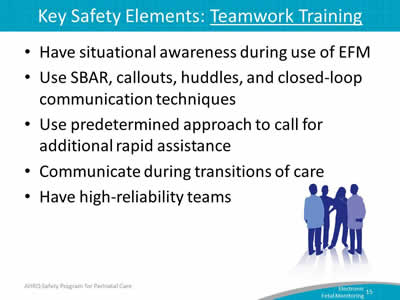
Say:
Teamwork training is the next key safety element. Here are important components of teamwork training:
- Situational awareness during use of EFM refers to all staff caring for the patient knowing what the patient's plan is through briefings and team management, being aware of what is going on and what is likely to happen next, and what resources are available if needed. In the context of EFM, situational awareness is particularly relevant for Category II tracings, where continued surveillance is often required before a definitive course of action can be determined, and staff need to know what resources are available to them should the patient's status suddenly change.
- SBAR, or Situation, Background, Assessment, and Recommendation, as well as callouts, huddles, and closed-loop communication techniques are also important elements of teamwork training for safe EFM use.
Other components of team training are—
- Use of a unit-established process for eliciting a rapid response for specific Category III EFM findings requiring immediate action.
- Use of transition communication techniques to ensure a shared mental model of plan of care and perceived risks between shifts or between units.
- Use of high-reliability teams.
Slide 16: Key Safety Elements: Teamwork Training
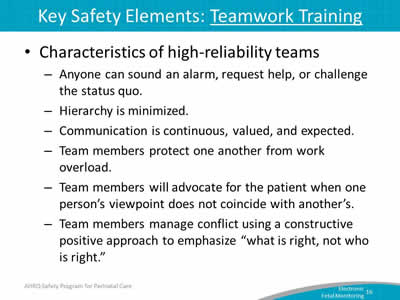
Say:
High-reliability teams are a part of teamwork training.
High-reliability teams are teams in which anyone can sound an alarm, hierarchy is minimized, and communication is continuous, valued, and expected. Team members protect one another from work overload, and place requests or offers for assistance in the context of patient safety. Team members will advocate for the patient when one person’s viewpoint does not coincide with another’s.
Team members manage conflict using a constructive positive approach to emphasize “what is right, not who is right.”
Slide 17: Key Safety Elements: Patient and Family Engagement
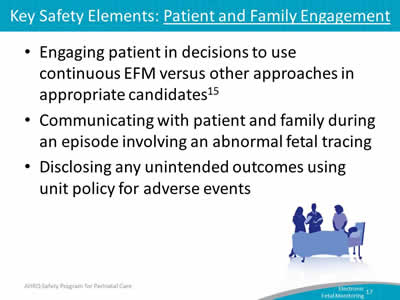
Say:
Some units may elect to offer appropriate patients the option of selecting between continuous EFM and intermittent auscultation or other approaches to fetal monitoring. A unit-established process could specify patient, nurse, and unit criteria for use of intermittent auscultation—for example, maternal criteria, nurse competency, or experience required, unit staffing ratio required for use. The process could include a discussion of risks and benefits of using continuous EFM versus intermittent auscultation with patients.
It is important to communicate with the patient and her family during an episode involving an abnormal fetal tracing. The patient and her family are a part of the team, and there needs to be a shared mental model with them as well as the clinical team. The provider, RN, or other delegated staff speaks to patient and partner regarding the urgency of the situation and what may happen next. Reassurance is given continuously.
Finally, unit staff should disclose any unintended outcomes related to EFM use using unit policy for adverse events.
Slide 18: Unit Next Steps
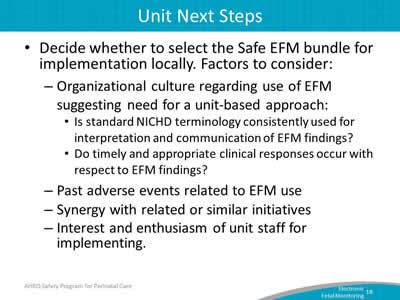
Say:
The next steps for your unit include the following:
Decide whether to select the EFM bundle for implementation locally. Factors to consider:
- Organizational culture regarding use of EFM suggesting need for a unit-based approach.
- Whether standard NICHD terminology is consistently used for interpretation and communication of EFM findings.
- Whether timely and appropriate clinical responses occur with respect to EFM findings.
- Past adverse events related to EFM use.
- Synergy with related or similar initiatives (e.g., initiatives to standardize EFM nomenclature).
- Interest and enthusiasm of unit staff for implementing.
Slide 19: Unit Next Steps
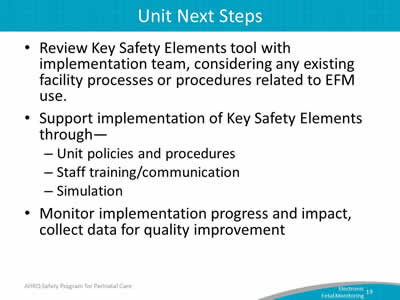
Say:
Review Key Safety Elements tool with implementation team, considering any existing facility processes or procedures related to EFM use.
Support implementation of Key Safety Elements through—
- Unit policies and procedures.
- Staff training/communication.
- Simulation.
Monitor implementation progress and impact, collecting data for quality improvement to refine the unit approach to the safe use of EFM.
Slide 20: Tips for Implementation Success
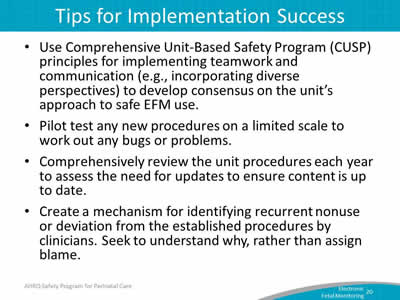
Say:
Here are some tips for implementation success:
- Use CUSP principles for implementing teamwork and communication (for example, incorporating diverse perspectives) to develop consensus on your unit's approach to safe EFM use.
- Test any new procedures on a limited scale to work out any bugs or problems.
- Comprehensively review your unit procedures each year to assess the need for updates to ensure content is up to date.
- Create a mechanism for identifying recurrent nonuse or deviation from the established unit policies or procedures by clinicians. Seek to understand why, rather than assign blame. Gaining buy-in from champions or other influential individuals can help in getting individuals who resist new approaches onboard.
Slide 21: References
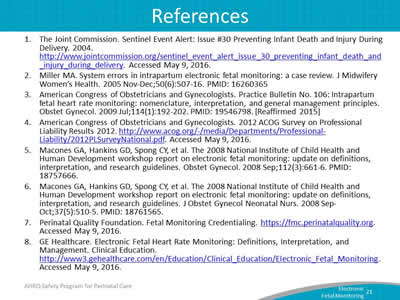
Slide 22: References
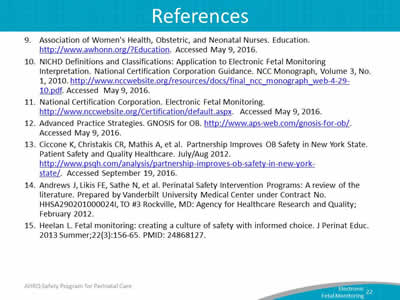
Slide 23: Disclaimer
